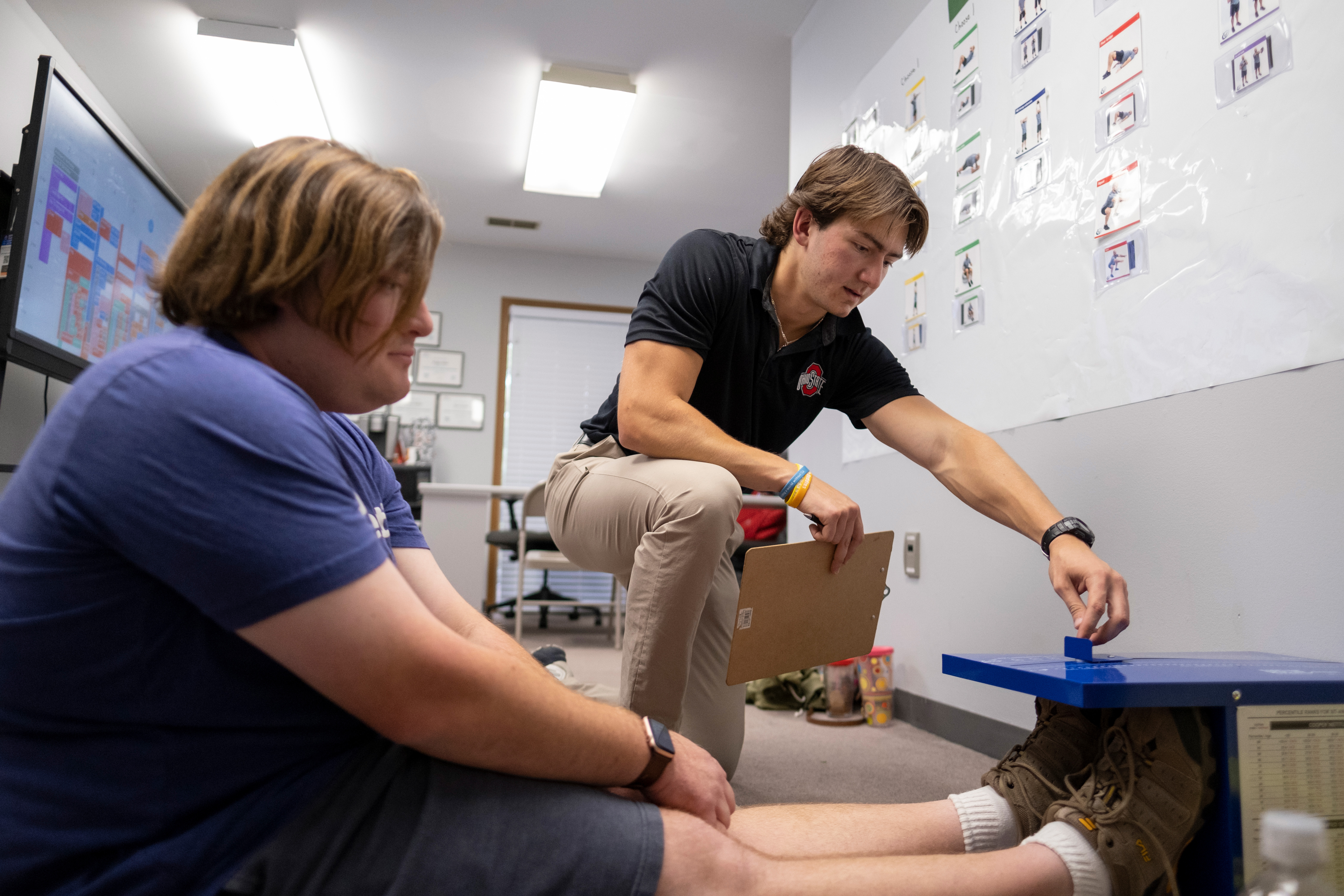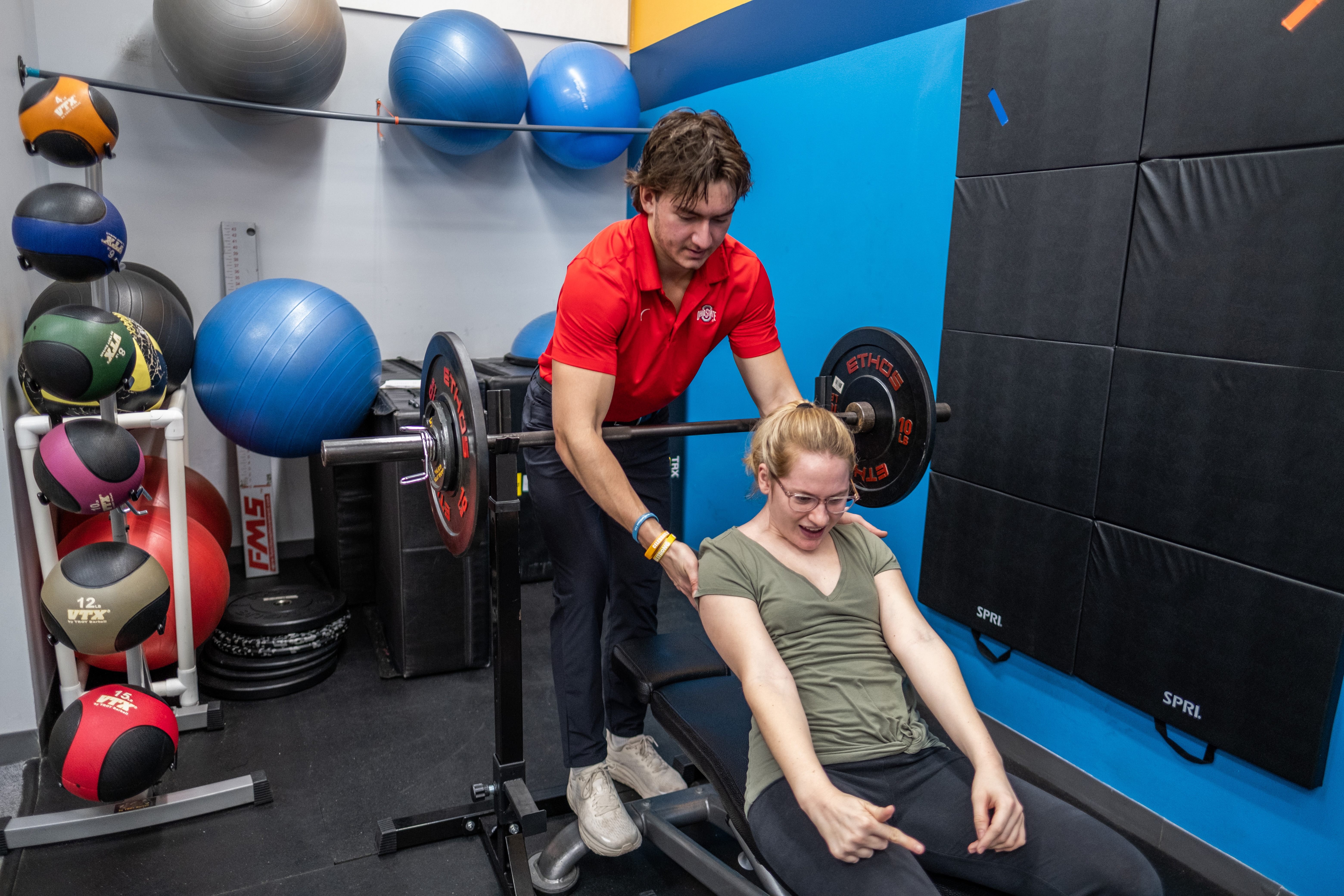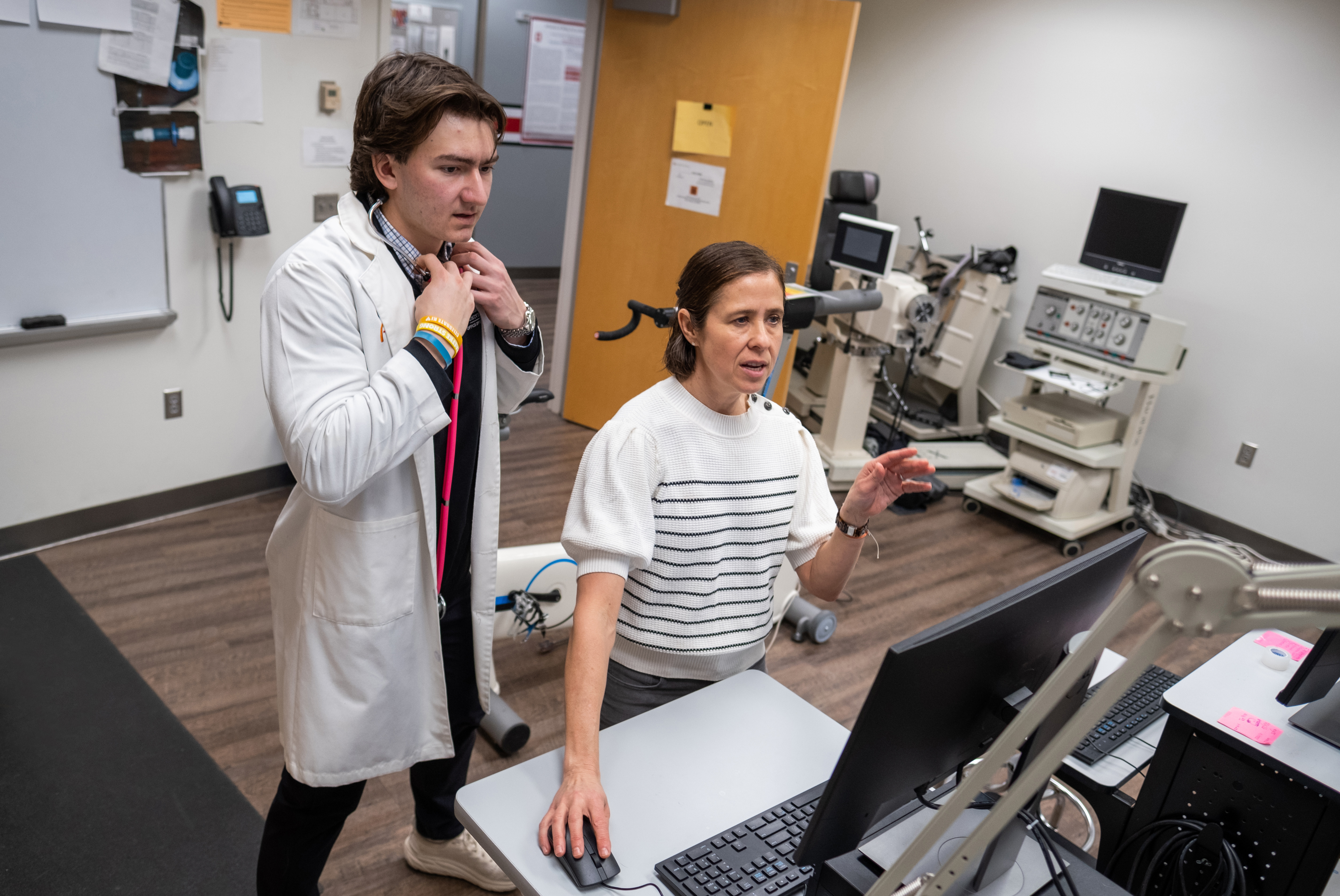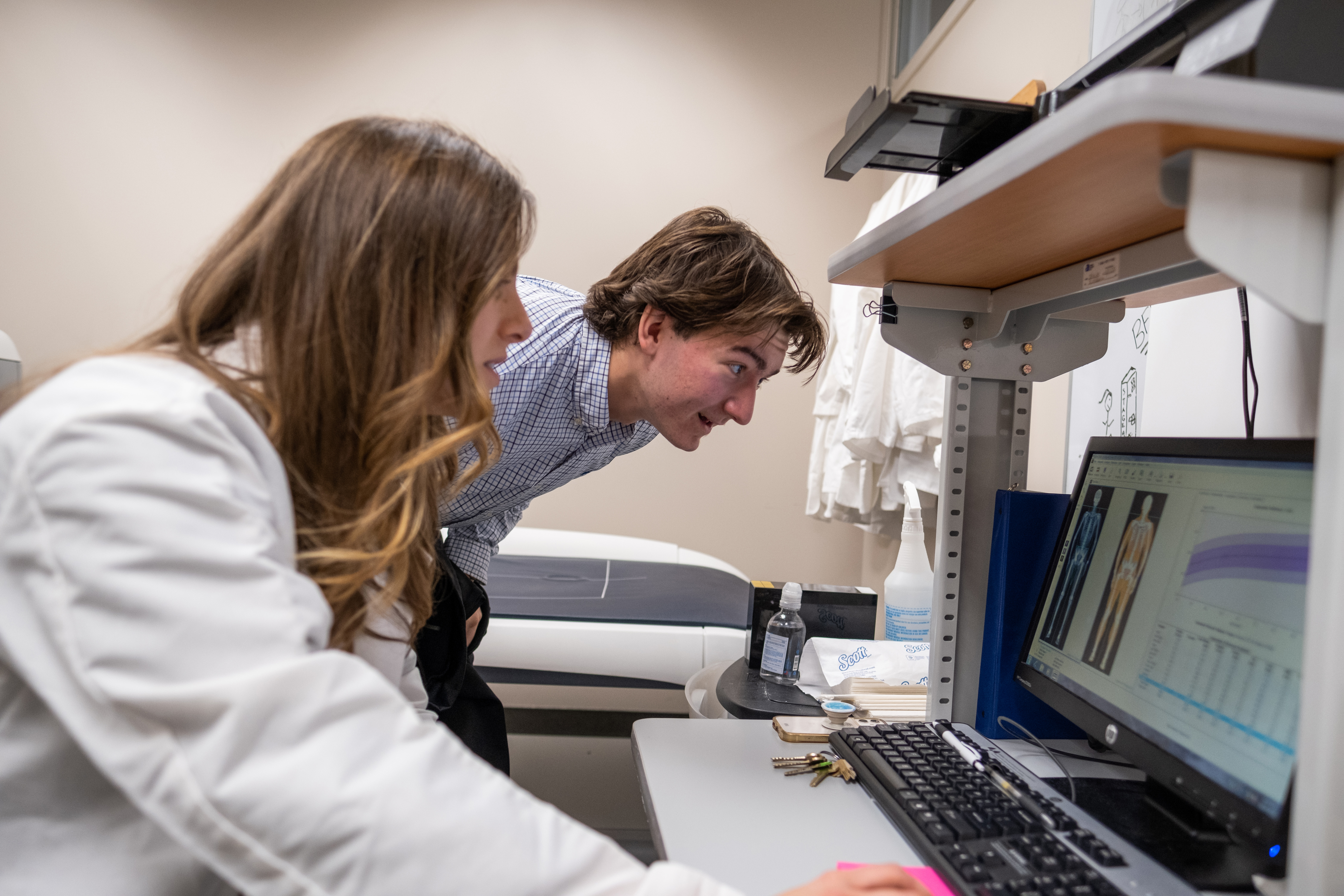Stepping out of his comfort zone and into his future
This exercise science student chased opportunities by knocking on doors. The ones that opened changed his life.

It starts on a couch in his parents’ basement. Cleveland, Ohio. Sent home to stay home in March 2020, his freshman year at Ohio State, Anthony Dujmovic spent days, months on that couch. Learning exercise science through Zoom.
And time went by.
Tick. Tick. Tick.
The back half of his freshman year. His entire sophomore year.
Tick. Tick. Tick.
Isolated. Bored. He dreams of becoming a physical therapist, working with athletes, maybe even pros one day. But how’s he going to get there from the couch? Learning how to use DEXA scans and body fat calipers off PowerPoint slides?
Sure, the grades were excellent, he’s learning plenty, but what hands-on experience has he gained?
“Time was just going by. I was like, I have to figure something out,” recalls Anthony, a first-generation American whose parents fled war-torn Croatia to give him and his sister opportunities, a better life. “I need to make something of myself. All the sacrifices my parents made, I wouldn’t be able to live with myself if I don’t.
“Next thing I knew, I was a junior, no experience. I didn’t really know anything. I was like, when things open up, I’m jumping in headfirst.”
So he did.
By the time Anthony graduated in December 2022 with a degree in exercise science, he was looking forward to beginning Ohio State’s highly selective Doctorate of Physical Therapy/PhD program to become a clinical physical therapist. He was also writing an academic paper about his own research study.
Along the way, he’d see firsthand how physical therapy and exercise change lives. But to get there required becoming comfortable with being uncomfortable.
‘I was literally terrified’
It’s 4 a.m. on a fall day in 2021 and Anthony is in a carload of graduate students he barely knows, driving to Kenton, Ohio, a small community that Anthony has never heard of.
Day after day, Anthony travels quietly for hours to rural areas to help with a study on obesity.
“I was literally terrified, I was afraid of messing up, saying something stupid,” he says. “I remember driving out to those YMCAs at 4 a.m. and I’m like, ‘What am I doing? I can’t do this.’”
He got himself into this by firing off a barrage of emails, asking for opportunities to get involved in research, work, anything. Knocking all the doors in the College of Education and Human Ecology.
Brian Focht, Vice Chair of Human Sciences, welcomed Anthony to his exercise and behavioral medicine lab, which promotes exercise, nutrition and behavioral counseling for healthy lifestyle changes.
Anthony began working on two studies in particular. One involved head and neck cancer survivors or those going through treatments. At the gym in the Physical Activity and Education Services building, Anthony led participants through exercises and made sure they were meeting with dietitians.
“It was impressive to watch [Anthony] work with people. He makes them feel valued, not just a subject in a research study. He has this kind of cool, calm, collected vibe that resonates well with people.”
In the other study, he helped with health assessments and testing for overweight or obese patients in rural Ohio, hence the early morning drives.
“These were six, seven-hour days, up at 4 a.m. but Anthony was so eager to be involved,” says Jessica Bowman, former program manager for Focht’s lab. “The more we had available, the more he wanted to do.
“Anthony wanted to work directly with patients. It was impressive to watch him work with people. He makes them feel valued, not just a subject in a research study. He has this kind of cool, calm, collected vibe that resonates well with people. And to see the confidence he’s gained has been incredible.”
Along with working in Focht’s lab, Anthony got heavily involved in other areas of PAES, home to world-class equipment, laboratories and researchers focused on exercise science. He helped faculty members with workouts through the Faculty Staff Fitness program. He also became a teacher’s assistant for Carmen Swain, Senior Lecturer in the Department of Human Sciences, who became an invaluable mentor.
“I was super intimidated by everyone at PAES,” Anthony says. “I just wanted to be a fly on the wall. But getting involved became the greatest decision of my life.
“A big reason for that was Dr. Swain. Everyone loves and respects her. Being her student, I felt like I had a place here, like I was doing good things. I found comfort in myself by being under her wing.”
In his personal life as a gym rat and long-distance runner, and from his work with people, Anthony saw firsthand the power of physical activity. And when spring 2022 arrived, Swain handed him an opportunity that changed his life.

‘I wanted to do this justice’
Anthony is celebrating his 22nd birthday on October 5 by guiding Anthony Paul through a pre-test workout to begin an eight-week exercise study.
Anthony demonstrates how to properly stretch for the flexibility test. At the bench press, he demonstrates exactly where to place your hands, how to hold your wrists. Once, twice, a few times, Anthony corrects Paul at station after station.
Safety. Repetition. Patience.
Paul is the first of 25 participants.
Paul is also autistic.
So is Zayne Harshaw, another participant. Kristen Manifold has cerebral palsy. Max Halpern has Down’s Syndrome, one eye, one kidney and a host of other health challenges. Twenty-five adults volunteered for the study, each living with an intellectual or physical disability that means having a caretaker their entire lives. For most, that’s a parent.
The first week of working with this population is a jolt.
“Walking into that gym the first time, I was like, how can I possibly do this? I sat in my room and cried every single night of that first week,” Anthony says. “I never really knew anyone with an intellectual disability. I never put myself in their shoes, thought about how hard it was, how hard it was for their parents. That thought was breaking me. But it also motivated me to do this right, to do this study justice.”
Swain and Anthony designed the “Valid Study” to explore the effectiveness of a fitness system developed by Peggy Mills, owner of Dublin, Ohio’s Valemee Fitness, an inclusive gym that uses her system to promote fitness, independence and self-efficacy in adults with intellectual disabilities (ID).
The United States National Physical Activity Plan and Centers for Disease Control and Prevention identify adults with ID as a target community to promote physical activity because this population has some of the highest rates of obesity, diabetes and chronic heart disease. As Mills often says, there’s a gym on every corner, but few have the trainers or a system like hers for someone with a disability.
Mills has worked with this population most of her career. She was an adaptive physical education teacher in the Dublin school system before retiring to start Valemee, where the Valid study took place from October 2022 to February 2023.
“There’s a huge gap between the opportunities people with intellectual disabilities have and what everyone else has. We need to fix that.”
She says once you begin working with this population, it changes you. She saw that in Anthony.
“He’d get choked up talking about it,” Mills says. “It’s going to be really impactful. He’s going to know everyone deserves the same amount of therapy and intervention. He’s going to know these are real people.”
School systems provide those with disabilities educational services, including exercise and recreational outlets, until they’re 22. Once they leave, they and their families are on their own. It’s a challenge that 35-year-old Max and his family know all too well.
“When you’re out of school, recreational opportunities, social circles, that responsibility falls on the family and one of those aspects is physical fitness,” says Dr. Barry Halpern, Max’s father. “With Max, when he was a teenager he was fit and trim. But through his 20s and 30s, he put on 25 pounds, and he’s not very tall so it’s significant.”
Like many families with children who have intellectual disabilities, Halpern says they give Max as much independence as possible, including choosing what he eats. When it comes to exercise, Max is dependent on Dr. Halpern and his wife. That hasn’t been easy at most gyms. Gwen Harshaw, Zayne’s mom, was recently diagnosed with diabetes herself and worries about Zayne’s long-term health. Though he’s a rockstar on stage — his band Blue Spectrum plays gigs throughout Columbus — the 27-year-old hadn’t been interested in exercise until he got involved in the study. That concerned her.
“I want him as healthy and happy as possible but he’s a grown man, it hasn’t been easy to motivate him,” says Gwen, who is also the program director for the Ohio Center for Autism and Low Incidence (OCALI).“Being sedentary is horrible, it leads to life-long problems. When you’re a parent to someone with a disability, your greatest fear is what’s going to happen if I die? It’s an overwhelming fear, what’s going to happen if I’m not there to protect him anymore. Part of that fear is his physical health.”

None of the 25 participants had been part of an exercise program like Mills’ prior to the study and most didn’t exercise regularly since leaving school.
However, results after eight weeks of the program showed increased fitness, independence and self-efficacy across the board. Participants also overwhelmingly said they were going to continue exercise and nutrition programs going forward, whether at home or by finding opportunities in their community.
Swain says the results — 96 percent participation and excitement to continue exercising — were like nothing she had seen in her previous studies.
“There was so much hugging,” Swain says, “That’s the one thing I remember, just a lot of hugging after it was all done. People came in wary of you and they left feeling so confident, so empowered. Of all the research I’ve ever done, this was the most meaningful.”
Though Valemee’s doors closed early this year, Mills is educating trainers to institute her system. It’s showing up in gyms throughout Columbus, and she’s also working in Dayton, Kentucky and Colorado.
However, the study almost never happened. Swain had taken nearly a decade off as a researcher, focusing on her role as a mother of four children, a lecturer and overseeing the Exercise Science internship program.
The idea came from a previous student who had an internship at Valemee. At that point, Swain didn’t have the time or inclination to pursue the study. Once Anthony came under her wing, his talent and eagerness changed her mind.
“When I mentioned it to Anthony, he got so excited. And,” she whispers, “I love that. So I was like, let’s do it. I love research but I would never have done this project without Anthony.”
Swain has mentored Anthony through the entire study process, which served as his capstone. Though adults with intellectual disabilities have so many health issues related to lack of exercise and obesity, there’s little research on exercise interventions. That often results in a lack of light on the problem.
“There’s a huge gap between the opportunities people with intellectual disabilities have and what everyone else has. We need to fix that,” Anthony says. “It’s obviously been an overwhelming experience but it’s been rewarding in ways I never would have imagined.
“Watching someone learn to do a compound movement like a bench press when they can’t sign their name on a consent form or tie their shoes was incredible. Their resiliency with everything life’s thrown at them, I’ll never forget that. I stepped out of my comfort zone to do this but so did they, and that’s where growth happens.”
‘I wouldn’t recognize myself from four years ago’
It’s February and Anthony is one of over 100 students presenting at the College of Education and Human Ecology research festival. But he’s one of only seven undergraduates in that group.
The rows of presenters are easy to navigate until you get to Anthony’s; his throng of supporters overflows into the aisle.
Among the crowd are Focht, John Buford, director of Ohio State’s Department of Physical Therapy, and Swain, who invited everyone she could think of, including her student Julia Grzesik, a junior exercise science major.
Inspired by Anthony’s work, Grzesik will begin her own study this summer.

“I thought research was something you did for a PhD but the more I learned about Anthony’s project, the more I wanted to do my own,” says Grzesik, also a first-generation American whose parents are from Poland. “Anthony just killed it.”
Buford agrees; when asked why Anthony was accepted into the DPT/PhD program, which only takes 50 students per year, he said, “He’s one of our top admits to the program. Everything he’s done, it’s exceptional.”
Burford says having a close working relationship with a mentor like Swain gave important insight during the acceptance process.
“Anthony is incredibly talented but more than anything, he’s always trying to do more,” Swain says. “I’ve loved working with him.”
What’s ahead of Anthony is writing a manuscript for academic publication, a rare feat for an undergraduate, while beginning the DPT/PhD program to become a clinical physical therapist.
“I look at physical therapy so differently now,” Anthony says. “Understanding the challenges people may have, it’s shown me the value of what we can do for people.
“I wouldn’t even recognize myself from four years ago. I remember the first time I spoke with Dr. Focht, I was so freaked out, so nervous. But at the EHE research day, I was so calm talking to him. For so long, I was socially awkward, full of anxiety, but now I expect so much from myself. I’m a completely different person now.”